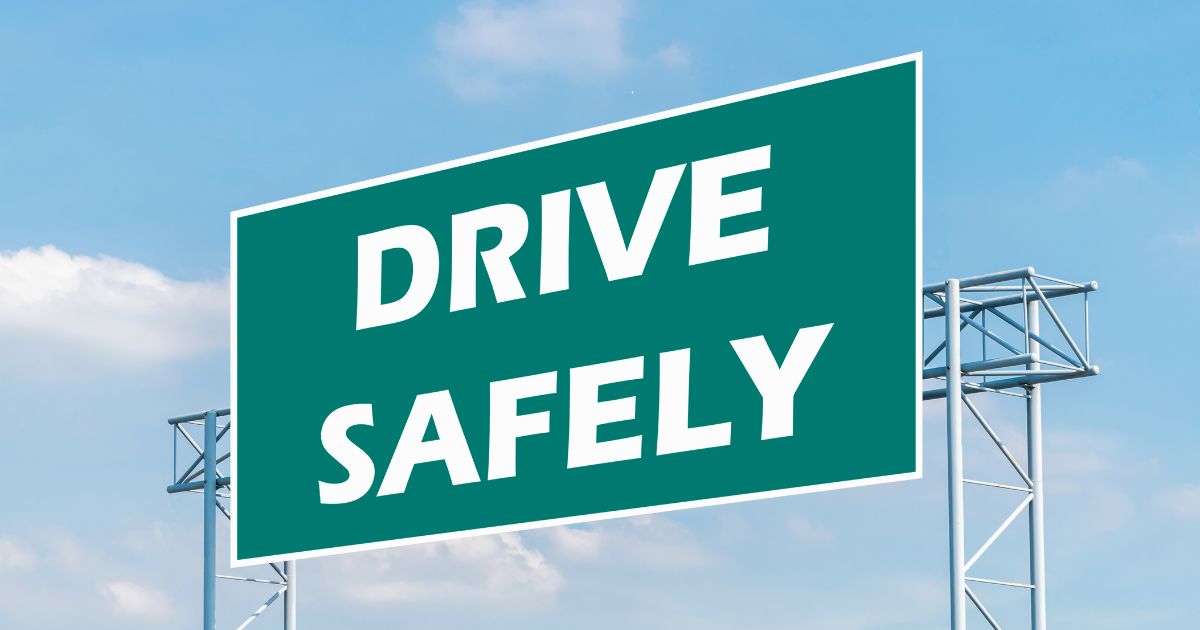When someone heads out on the road, it’s natural to want them to drive safe. We often say “drive safe” as a simple reminder to stay cautious while driving. Whether it’s a short trip or a long journey, the message is always the same: take care behind the wheel.
In this article, we’ll explore 18 other ways to say drive safe, helping you express your wishes for someone’s safety in fresh, thoughtful ways. From casual phrases to more formal ones, each variation emphasizes the importance of a safe ride. Let’s dive in and find the best alternatives to say, “drive safe” in different situations.
Other Ways to Say “Drive Safe”
There are many other ways to say “drive safe” that sound more personal, warm, or fun. Whether you’re texting a friend or saying goodbye in person, you can use phrases like “travel safely,” “take care on the road,” or “don’t rush.” These expressions make your safety wish feel more thoughtful and human.
General Safety Wishes
General safety wishes show your care and concern for someone’s well-being while traveling. They express your hope for a safe and smooth journey.
1. Drive Carefully
Example: “Drive carefully, and text me when you get there.”
Meaning: A straightforward request for someone to be cautious while driving.
Usage: This is a universally suitable phrase that can be used in any situation where someone is leaving by car. It’s respectful and straightforward, making it ideal whether you’re sending a friend off for a quick drive or wishing a colleague well on their journey. It emphasizes the importance of caution on the road, without being overly formal or impersonal.
When you use “drive carefully,” you’re not just wishing for a safe journey but also showing care for the other person’s well-being. It’s a phrase that balances emotional expression with the practical reminder of staying safe, especially in busy or challenging traffic conditions.
2. Stay Safe
Example: “Stay safe, and I’ll see you soon!”
Meaning: A broader expression of well-wishing for safety, not just for driving but for any situation.
Usage: “Stay safe” is a versatile phrase that can be used in any situation where safety is a concern, whether someone is heading out on a long drive, traveling for work, or simply leaving home. It’s a general safety wish that conveys care without being too specific about the circumstances. You might say it when you’re concerned about more than just the person’s driving, such as when they’re dealing with bad weather, heavy traffic, or any potential risks along the way.
This phrase is great for casual goodbyes to friends, family, or even colleagues. It communicates respect and care, and it’s especially meaningful in contexts where you want to make sure the person feels supported without making a big deal out of the situation. “Stay safe” is simple but heartfelt, and it can be used both when someone is leaving for a quick trip or a significant journey.
3. Have a Safe Ride
Example: “Have a safe ride, and enjoy your trip!”
Meaning: A friendly and casual way to wish someone well on their journey, specifically focused on the drive.
Usage: This expression is more informal than others like “drive carefully” but still expresses genuine concern for the person’s well-being on the road. It’s often used in informal settings, such as when you’re bidding farewell to a friend or family member heading out on a short trip or a road trip. While “drive carefully” is more direct, “have a safe ride” has a lighter, more relaxed tone, making it perfect for casual goodbyes.
“Have a safe ride” is a great way to show care without being overly serious, especially when the person isn’t embarking on a long drive or facing particularly dangerous conditions. It’s a way of reminding them to stay alert and mindful while also encouraging them to enjoy their time on the road. Whether the journey is through busy traffic, a challenging drive, or calm roads, this phrase fits well in almost any situation.
Specific Safety Instructions
Specific safety instructions go a step further than just saying “drive safe.” They offer direct guidance to help someone avoid danger. Saying things like “eyes on the road” or “mind the speed limit” reminds drivers to stay focused, avoid distractions like texting, and follow traffic rules. These phrases are clear, helpful, and easy to remember.
4. Eyes on the Road
Example: “Make sure you keep your eyes on the road and stay safe.”
Meaning: A direct reminder to focus on driving and avoid distractions while behind the wheel.
Usage: This expression is typically used when you want to remind someone to stay vigilant and avoid distractions, such as texting, talking on the phone, or looking at the surroundings. It’s often said in situations where someone may be heading out on a long drive or traveling through busy traffic, where distractions could lead to accidents.
Using this phrase can convey your care for someone’s safety without sounding overly strict. It’s an important safety reminder that emphasizes focus on the road, especially when someone may be driving in challenging conditions or bad weather. This expression is best used with those you’re concerned about, like friends or family, but can also be used with colleagues or acquaintances in a casual setting to remind them to stay alert on the road.
5. Mind the Speed Limit
Example: “Mind the speed limit, and have a safe trip!”
Meaning: A polite reminder to follow speed regulations for the person’s safety and the safety of others.
Usage: This phrase is commonly used when you want to make sure the person driving is aware of their speed and staying within legal and safe limits. It’s especially useful when someone is heading out on a road trip or a long drive through unfamiliar areas or highways, where they might be tempted to speed.
It’s a good phrase to use in situations where safe driving is a priority. In areas with heavy traffic or challenging driving conditions, like rainy weather or busy roads, reminding someone to “mind the speed limit” can help prevent accidents. This phrase is a bit more specific than other general well-wishes but still lighthearted enough for a casual good-bye. Whether you’re saying it to a family member or a colleague, it ensures they’ll be aware of their responsibilities behind the wheel.
6. Keep an Eye on the Road
Example: “Keep an eye on the road, and drive safely!”
Meaning: A variation of “eyes on the road,” it reinforces the idea of focusing entirely on driving to avoid distractions.
Usage: “Keep an eye on the road” is a friendly and caring way to remind someone to stay focused while driving. It’s often said in situations when you’re concerned about someone’s attention span while driving, especially if the person might be dealing with distractions, like loud passengers or the temptation to use their phone. It’s an expression that conveys care and emotional expression without being too formal.
This phrase can be used in a variety of contexts, from casual situations to more serious reminders. For example, it works perfectly when someone is about to set off on a long drive through unfamiliar places or if they’re facing potentially challenging conditions on the road, such as poor weather, heavy traffic, or complex intersections. It’s a good way to express your concern for their safety while still sounding lighthearted.
7. Mind the Traffic
Example: “Mind the traffic, and drive safe!”
Meaning: A reminder to pay attention to the road and other vehicles, especially when driving in busy traffic or congested areas.
Usage: This phrase is particularly useful when someone is about to navigate through busy traffic, either in the city or on highways where congestion can be common. It’s a simple yet effective reminder to be mindful of other drivers and to stay alert. You might say this to someone leaving for a significant journey or simply heading home from work.
“Minding the traffic” is a context-specific reminder that can be used to gently nudge someone to be more cautious. Whether someone is heading through rush hour, road construction zones, or just a challenging drive, this phrase serves as an important safety precaution to avoid accidents and to drive at a safe pace. It’s a friendly way to acknowledge that traffic can be unpredictable and to encourage drivers to stay calm, composed, and vigilant.
Care and Caution Reminders
Care and caution reminders go beyond just saying “drive safe.” They gently urge someone to stay alert and act responsibly while driving. Phrases like “be careful on the road” or “take it easy” show concern in a kind, respectful way. They suit any situation, from everyday errands to longer trips.
8. Take it Easy on the Roads
Example: “Take it easy on the roads, and get there safe!”
Meaning: A casual reminder to drive at a comfortable speed and not rush.
Usage: This expression is often used when someone is heading out on a long drive or a casual trip. It’s a friendly and laid-back way of advising someone to avoid rushing and to maintain a safe pace. Saying “take it easy on the roads” suggests that the journey should be enjoyable, and there’s no need to speed or drive aggressively.
This phrase can be especially useful in situations where someone is driving through challenging conditions such as bad weather or heavy traffic. It’s also a nice way to remind someone to relax and enjoy the scenic drive rather than feeling rushed or stressed. Whether it’s a family member, friend, or colleague, saying this conveys care without being overly formal or serious.
Read More: 17 Other Ways to Say “Never Mind”
9. Be Careful on the Road
Example: “Be careful on the road and drive safely!”
Meaning: A simple, straightforward way to express concern for someone’s safety while they’re driving.
Usage: “Be careful on the road” is a general safety reminder that can be used in almost any situation. Whether someone is about to leave for a short drive or a long road trip, this phrase is a friendly and effective way of showing you care. It’s perfect for those heading out through busy traffic, bad weather, or any other challenging conditions where they might face potential risks.
This phrase works well in casual goodbyes with friends and family and can also be used in professional settings when you want to wish someone a safe trip, especially if they’re about to travel through unfamiliar or risky areas. It’s not overly formal, so it strikes the right tone for most contexts where you’re expressing concern but still want to sound relaxed and friendly.
10. Take Care on the Road
Example: “Take care on the road, and have a smooth journey!”
Meaning: A caring and warm expression to wish someone a safe trip, encouraging them to be mindful of their driving.
Usage: “Take care on the road” is similar to saying “be careful,” but it has a slightly more personal and thoughtful tone. It’s often used when someone is about to embark on a significant journey or a challenging drive. This phrase suggests not just paying attention to the road but also taking time to ensure overall safety, which includes taking care of their vehicle, being alert to traffic, and adjusting their driving based on the conditions of the roads.
It’s an excellent choice when you want to convey that you genuinely care about the person’s well-being and want them to have an enjoyable trip. Whether it’s a family member heading out for a long drive or a colleague driving in busy traffic, this phrase is a warm and comforting way to wish them well without sounding too formal.
Wishes for a Pleasant Journey
Wishes for a pleasant journey offer more than a simple “drive safe.” They express care, warmth, and thoughtfulness. These phrases make farewells more meaningful, whether someone is going on a short trip or a long adventure. Saying “travel safely” or “bon voyage” adds a personal, kind touch to any goodbye.
11. Travel Safely
Example: “Travel safely, and I’ll see you when you get back!”
Meaning: A sincere wish for someone to have a safe and smooth journey.
Usage: “Travel safely” is a polite and considerate phrase that can be used in almost any context where someone is heading out on a trip, whether it’s a short commute or a long journey. It’s particularly appropriate when someone is about to travel to a new place or when they are signing off after a casual or professional encounter.
This phrase emphasizes safety as the primary concern, especially in situations where the person may be traveling through areas with heavy traffic, bad weather, or other potential hazards. It’s perfect for family, friends, or colleagues, conveying care without sounding overbearing.
12. Journey Well
Example: “Journey well, and make the most of your trip!”
Meaning: A slightly more formal way of wishing someone a safe and pleasant trip.
Usage: “Journey well” is a great phrase to use when you want to convey a bit more formality and respect for the person’s trip. While still friendly, it works especially well when you’re saying farewell to someone heading out on a significant journey. It’s a phrase that suggests you hope their trip is successful and enjoyable, while also wishing them a safe ride.
This expression can be used in both professional and personal settings, particularly when the person is traveling for an important reason or to a distant location. It’s suitable for use with friends, family, or business associates, making it versatile and thoughtful.
13. May Your Journey Be Smooth
Example: “May your journey be smooth, and may you have an easy drive!”
Meaning: A warm and positive wish for someone to have an enjoyable and safe trip.
Usage: This phrase conveys a sense of hope for an enjoyable and trouble-free trip. It’s often used when someone is about to head out on a long drive or a significant journey, where there may be obstacles to overcome, such as bad weather or heavy traffic. This phrase is a bit more formal than some of the other suggestions but is still friendly enough to be used with anyone.
It’s a great way to express your well wishes for someone about to set out on a trip, whether they are going on vacation, visiting family, or heading to work. It shows you care about their safety and comfort on the road and hope they encounter no obstacles.
14. Bon Voyage
Example: “Bon voyage! Have a wonderful and safe trip!”
Meaning: A classic farewell phrase, especially popular in formal settings, wishing someone a great journey.
Usage: “Bon voyage” is a timeless and slightly more formal expression, often used to wish someone a pleasant trip, especially when they are traveling to far or exotic destinations. It can be used for both professional and personal contexts, such as when a colleague or loved one is going on a vacation, business trip, or any significant journey.
This phrase carries with it a sense of good wishes and is often used with those you respect or admire. It’s a great choice when you want to convey positive feelings for someone’s journey, whether they’re leaving for a long trip or simply heading out for a few days. It adds a touch of class and thoughtfulness to your farewell.
Casual, Light-hearted Warnings

Casual, light-hearted warnings use humor to remind someone to be careful. It’s a relaxed way to say drive safe with a smile.
15. Watch Out for Crazy Drivers!
Example: “Watch out for crazy drivers! Stay safe out there!”
Meaning: A light-hearted and somewhat humorous way of cautioning someone to be aware of reckless or unpredictable drivers on the road.
Usage: This phrase is typically used in casual situations when speaking to family, friends, or even colleagues who may be traveling through areas known for reckless driving or busy traffic. It adds a bit of humor to the standard safety reminder while still emphasizing the importance of being aware of your surroundings.
While it’s a more relaxed expression, it also serves as a serious reminder about the dangers of distracted driving and road rage, encouraging the listener to stay alert to avoid any unexpected situations. It’s especially suitable for short trips or when you know the person will be driving through areas with high traffic or challenging conditions. Although the phrase uses humor, it still conveys genuine concern for the person’s safety.
16. Stay Alert, Stay Safe
Example: “Stay alert, stay safe! Have a good trip!”
Meaning: A more serious yet still friendly reminder to remain vigilant while driving, especially in areas where distractions or dangers may be prevalent.
Usage: This phrase is a straightforward and direct way of wishing someone safe travels. It emphasizes the importance of being vigilant and aware of one’s surroundings. It’s commonly used in professional settings when wishing colleagues or clients safe travels, but it can also be used with friends or family.
“Stay alert, stay safe” works particularly well in situations where the person may be driving in busy traffic, during nighttime, or through areas with high risk such as highways or unfamiliar roads. The phrase is serious but still accessible, making it appropriate for situations that require both caution and careful attention to road conditions. It’s a reminder to focus on the task at hand and avoid distractions like texting while driving.
Emphasizing Non-Haste
Emphasizing non-haste reminds others to slow down and take their time. It’s a thoughtful way to say drive safe without rushing.
17. Don’t Rush, Take Your Time
Example: “Don’t rush, take your time! The road will be there when you get there.”
Meaning: A reminder to drive without feeling pressured and to prioritize safety over speed.
Usage: This expression encourages someone to avoid the temptation to hurry while driving. It’s a gentle reminder that punctuality is important, but safety should always come first. This phrase is particularly suitable for long drives, challenging trips, or when the roads are unpredictable due to factors like weather conditions or traffic congestion.
Saying “Don’t rush, take your time” shows concern for the driver’s well-being and the idea that arriving safely is more important than arriving quickly. It’s perfect for family members or friends who tend to be in a hurry or are feeling the pressure to reach their destination as soon as possible. The phrase promotes peaceful driving and calm decision-making, which helps reduce stress and road rage.
18. No Need to Hurry
Example: “No need to hurry! Take it easy and have a safe ride.”
Meaning: A relaxed reminder that the driver has time to drive without the need for urgency or stress.
Usage: This is another phrase that emphasizes non-haste and taking your time on the road. It’s particularly fitting when someone is leaving for a trip and there’s no rush to get to the destination. This can be used with family members, friends, or anyone heading out on a long journey or trip.
“No need to hurry” encourages a calm and safe approach to driving, especially when conditions may make the drive more challenging or time-consuming. It suggests that the person should drive at a safe pace without worrying about arriving at a specific time. This phrase is also a great way to reduce anxiety about the trip, allowing the driver to focus on staying alert and driving with caution rather than rushing.
In essence, this phrase serves as a reminder to prioritize well-being and safe driving over the stress of reaching a destination quickly. It’s also a good option for encouraging drivers to avoid reckless driving or becoming impatient with traffic or other delays.
The phrases we’ve covered here are all great ways to wish someone a safe journey while being mindful of the situation at hand. Whether you’re offering a general safety wish, reminding someone to be careful on the road, or adding a bit of light-hearted humor, these expressions can add a personal touch to any goodbye. By being thoughtful about the tone and context, you can show respect and concern for the person’s safety while they travel.
When to Use Different “Drive Safe” Alternatives
Use different “Drive Safe” alternatives based on who you’re talking to, the setting, and the tone you want to convey.
Family and Friends:
When speaking to family and friends, expressing care and concern is key. Phrases like “Drive safely” or “Take care on the road” are warm, emotional expressions that reinforce the importance of safety. These phrases emphasize a safe ride while conveying your desire for their safe journey.
Professional Settings:
In professional settings, it’s essential to be polite yet considerate. Using phrases like “Travel safely” or “Have a safe trip” works well in these situations. These expressions show respect and convey a message of safety without being overly personal, all while encouraging safe travels on their journey.
Informal and Casual Goodbyes:
For more casual goodbyes, expressions like “Take it easy” or “Watch out for crazy drivers” add a friendly, light-hearted tone. These casual phrases fit perfectly when wishing someone well on their trip, keeping the mood relaxed while still urging safe travel and caution on the road.
Significant Journeys:
For significant journeys, especially long trips, expressions like “Bon voyage” or “May your journey be smooth” are ideal. These farewell expressions show sincere care for someone’s safety and well-being, emphasizing a smooth, pleasant journey. It’s a thoughtful way to wish someone safe travels while acknowledging the importance of their trip.
Conclusion
There are many ways to say “drive safe” depending on the situation. Each phrase offers a unique way to wish someone a safe journey while on the road. Whether you’re talking to friends, family, or colleagues, these alternative expressions will help you sound thoughtful and caring.
Remember, drive safe is a universal wish, but now you have plenty of other options to express it in fresh ways. Keep these phrases in mind next time someone is heading out, and let them know you care about their safety. Keep it simple, meaningful, and most of all, drive safe!

Grammerroot is your trusted source for mastering English grammar and language skills. From simple rules to advanced tips, we help learners build strong foundations through easy-to-understand content. Learn smart, learn right — only at Grammer Root.




